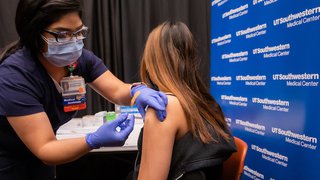The psychiatrist will see you now (by virtual visit)
September 23, 2020

Eventually, the COVID-19 pandemic will end – all pandemics do. And when it does, one silver lining will remain: telemedicine, particularly for psychiatry care.
Seeing patients via virtual visits is not new to UT Southwestern, and that is especially true for those of us in psychiatry and psychology. Several years ago, I was part of a program to launch telepsychiatry to serve patients with transportation challenges in East, West, and Central Texas, and even here in the Metroplex.
This spring, we quickly ramped up our capabilities to offer more virtual care during the early stages of COVID-19. Today, we follow nearly 15,000 UT Southwestern patients through telepsychiatry – 90% of our visits are now virtual, which has increased our bandwidth, enabling us to see 20% more patients than we could before the pandemic.
For more than a decade, I’ve cared for patients across the world through telepsychiatry, providing mental health support through crises such as Ebola and times of war.
Throughout the challenges we've faced then and today, telepsychiatry has proven to be remarkably similar to in-person care. The most notable difference is that, as a patient, you are screen-to-screen with your doctor instead of face-to-face.
Studies show high patient satisfaction with telehealth formats, and our patient satisfaction scores have increased since the pandemic began. Most importantly, our patients enjoy the benefits of the format.
5 benefits of telepsychiatry
1. Increased access to behavioral and mental health care
Telemedicine has long been a critical resource for patients who don’t have easy access to brick-and-mortar facilities such as our Psychiatry Clinic. Even for people who live within the Metroplex, it’s not always convenient to physically visit a doctor.
For example, I care for moms with postpartum depression. Even when you're well, going anywhere with children can be an arduous expedition. And it’s not always easy or affordable to find childcare or transportation. Being able to visit with your doctor from home can remove some of those obstacles.
2. Crossing the 'digital divide'
According to the Texas 2036 Project, a data-driven nonprofit, nearly 1 million people in Texas do not have access to broadband internet service – roughly 31% of rural Texans and more than a third of Dallas households.

This "digital divide" can be seen as a hindrance to telepsychiatry. However, we've found that the majority of patients who use our platform do so from their mobile device, accessing the web through their smartphone data or Wi-Fi. The ability to access telepsychiatry from "mobile-first" platforms is vital.
Pew Research data show that 81% of Americans own smartphones, including 71% of people who live in rural communities and 71% of individuals earning less than $30,000 a year. Moreover, 20% of American adults use their smartphones as their sole internet source at home.
In our experience, mobile devices are not only sufficient for virtual visits but, in many cases, preferred because they can provide better image quality than the standard desktop or laptop PC. For example, I've visited with patients who looked content until they moved their head and device a certain way and I noticed they were crying. That's a big detail in a telepsychiatry exam that we might have missed via desktop camera.
3. Overcoming the stigma of mental health care
Negative attitudes and beliefs about seeking mental health care have decreased over the years, but some unfortunately remain. Telehealth bypasses the potential barriers of being seen walking into a psychiatry clinic or sitting in the waiting room because it allows patients to visit with a professional from the privacy of their own home.
4. Comfort and control
Telemedicine is surprisingly intimate. It’s a virtual house call – patients are, in a sense, inviting me into their homes. That’s a privilege and honor, and it shifts some control to the patients. When a visit is in a doctor’s office, we control the setting and workflow by default. But when it’s in your home, you’re in control, which really is as it should be.
5. Reducing the number of physical visits
I work with colleagues across the health care spectrum to enhance patients’ physical and mental health. Psychiatric care can be beneficial when dealing with cancer, complex pregnancy, and many other medical conditions. Telehealth psychiatry removes the burden of having to fit in yet another trip to the doctor's office.
Related reading: COVID-19 distress: Managing your mental health in a pandemic
How Virtual Care is Becoming the New House Call
Dr. John Warner discusses the evolution and future of virtual care with Alan Kramer, architect of UT Southwestern’s telemedicine strategy, and Dr. Suzanne Cole, an early adopter of video visits and Medical Director of Simmons Cancer Clinic at Richardson/Plano.
What to expect in your video visit
Your video visit will be similar to meeting your psychiatrist in the office. We'll review any testing you might have had, which is sent to your doctor in advance through MyChart.
Then we will talk about how you are feeling, discuss any new or changing symptoms, and go over your medications and treatment progress. From there, we will discuss next steps for your care, just as we would in the office.
Tips for a successful appointment
The few elements that will be different mainly cover positioning and lighting so that we can see and hear each other:
- Camera position and lighting are important so the doctor can clearly see your face and read your body language. We might ask you to adjust where you hold or set your device during our call.
- I also want my patients to be able to see me and be comfortable with my set-up. Patients sometimes ask me to turn off my ceiling fan or shift positions to avoid distracting movements and lights – we want patients to know they can tell us these things.
- Privacy is always a priority, whether we are meeting in person or virtually. When I talk with patients, I am the only one in my office and I close the door.
I ask patients to find a place to meet in which they feel safe and comfortable. They can decide how much privacy they want or need from their end. I’ve had visits in which a child or partner occasionally walks through the room or joins the visit. Based on the discussion, the patient may ask to pause in order to relocate for a little more privacy.
When you might need to come to the office
We'll ask you to visit the clinic only for the few aspects of care that can't be done virtually. These might include:
- Interventional treatments, such as electroconvulsive therapy (ECT), repetitive transcranial magnetic stimulation (rTMS), or ketamine infusion therapy.
- Substance use disorder treatment. Some initial evaluations and drug testing sessions are still being done in person.
- Some geriatric psychiatry sessions. Many older patients are avid technology users, but some require in-person care.
If you do need to come to the clinic, UT Southwestern has extensive safety precautions and protocols in place to reduce the risk of COVID-19 exposure.
The future of telemedicine in psychiatry
Forthcoming technology will make telepsychiatry even more accessible for patients via mobile devices, particularly older patients. We're taking an approach with our platform that’s similar to Steve Jobs’ approach back in the 1980s – working toward making the interface easy to use, regardless of our patients’ level of tech-savviness.
Innovations in motion by my colleague Alan Kramer, M.P.H., Assistant Vice President for Health System Emerging Strategies at UT Southwestern, include single-touch or single-sign-on login instances for patients to securely access our telepsychiatry platform through their mobile devices. Biometric sign-ons such as thumbprint or recitation of a PIN number could be implemented for an additional layer of security.
For many mental health conditions, research shows that telehealth visits with a professional can be as effective as in-person visits. Equally as important, patients like the platform. I'm glad to say telehealth is here to stay, and it will only continue to improve.
To request a video visit for psychiatric care, call 214-645-8300 or request an appointment online.











